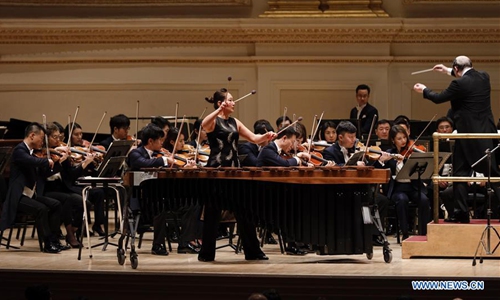HOME >> OPINION
Rigid art venue rules need to evolve with times
By Rong Xiaoqing Source:Global Times Published: 2020/1/9 18:48:41

Symphony Orchestra of the Central Conservatory of Music of Beijing performs at the Carnegie Hall in downtown Manhattan, New York on December 13, 2019. Photo: Xinhua/Li Muzi
A couple of decades back, New York's prominent performance venues such as Lincoln Center and Carnegie Hall were daunting places for many Chinese immigrants here. The programs, mainly ballet, symphony concerts or chamber music, catered to elite American culture; the prices of tickets were prohibitive for the blue-collar Chinese workers toiling in restaurants or in construction sites. Even for those who had both the taste for classical music and the means, the idea of sitting in an audience devoid of other Asian faces was not an appealing one.Gone are those days. In recent years, Chinese performers have presented at these traditional performance venues with increasing frequency. That's thanks to the growth in the number of local Chinese performers and China's extension of its soft power. The performances sponsored by Chinese government entities are particularly helpful in offering opportunities to working-class Chinese immigrants to visit these world famous venues. Some of the tickets are distributed by community associations in the New York area's Chinatowns to their members for free.
However, while Chinese immigrants are happy to watch performances rooted in their own culture at such historical venues, not everyone is pleased by the etiquette of their fellow audience members. In almost all the Chinese performances I watched, there would be some audience members indulging in questionable behavior and others pointing at them. A local Chinese newspaper even published an op-ed piece once to criticize the "uncivilized" Chinese audiences.
Initially, there were complaints about those eating snacks or chatting during a performance. But the Chinese immigrants got rid of the distractions as they got used to the social norms in performance halls. The problem that now seems to be of persistent concern is the use of smartphones. The temptation to take photos of the performance and post on social media platforms is so strong that it won't give way to even the sternest warnings from the eagle-eyed ushers.
Sometimes, the scenes can be comical. At a recent variety show at Carnegie Hall, I witnessed a young man ignoring numerous rebukes as he kept pulling out his phone to take photos whenever he thought the ushers were not looking. Eventually, a frustrated usher had to stand in the aisle beside the man's seat, arms crossed and staring at him for the rest of the show.
This may sound extreme, but to say the use of cell phones is a problem unique to Chinese audiences is to overlook the bigger picture. Indeed, cell phones have presented a new challenge to many American theaters whose rules were set in the pre-digital era. Every now and then, you'd see in the media a story about some major show that was interrupted when an audience member who could not stay away from his or her phone was escorted out.
The violations involve ordinary people and celebrities alike. Rihanna, for example, sent a message to the playwright of the Broadway show Slave Play during the show, which the playwright, Jeremy O. Harris, acknowledged on his Twitter account with pride. And Kanye West was found using his cell phone during a Broadway performance of The Cher Show. The rap star later explained that he was taking notes about the show.
While audacious intrusion with cell phones may be annoying to the performers and other audience members, it is not easy for traditional theaters to fight this battle. For one thing, to expel a rule-breaking audience member during the middle of the performance is always a hard decision as it may cause a bigger interruption of the show. But what's thornier is that these traditional performance venues themselves have quietly evolved with times, and that sometimes puts their primal rules in an awkward position.
A few years ago, I watched a Chinese pop band performing in the Lincoln Center. The audience members, mostly young Chinese students, pulled out their phones one after another and turned on the light beams to interact with the performers. While the horrified ushers were desperately trying to stop this, the performers on the stage pulled out their phones to respond to the audience. While the ushers looked on in shock and incredulity, the theater was turned into a night sky with shining stars, a scene that happens more often at rock concerts at the Madison Square Garden than the Lincoln Center.
This was only one of the unusual struggles I have watched at the classical performance venues in the past few years, and the full list extends to a much broader variety of art forms from solo pop star concerts to stand-up comedy. The eligible use of these traditional concert halls has expanded a lot in recent years. Different art forms bring in audiences with different behavior codes. How this meshes with the rigid one-size-fits-all rules of the traditional theaters is a drama worth watching.
The author is a New York-based journalist and Alicia Patterson fellow. rong_xiaoqing@hotmail.com
Posted in: COLUMNISTS,VIEWPOINT